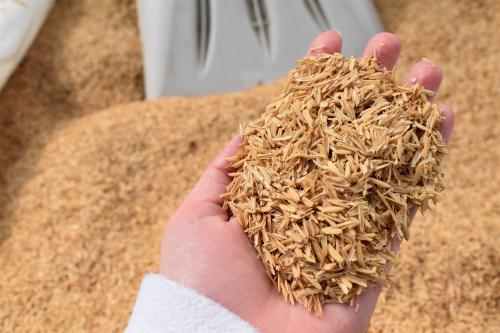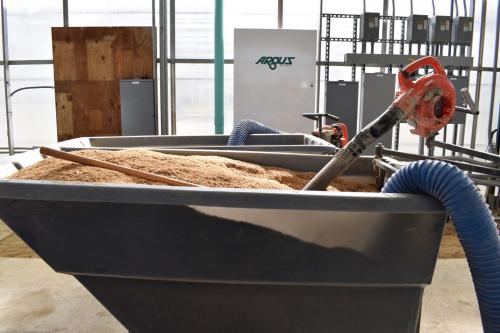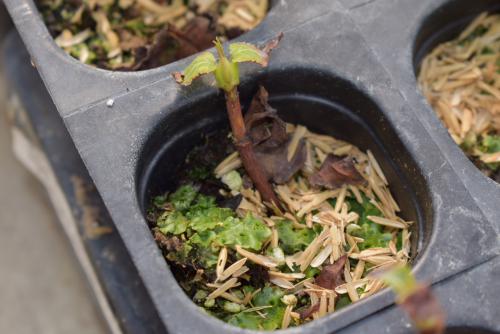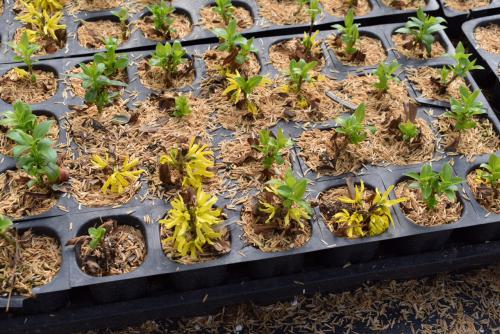Topdressing container nursery plants for liverwort control
Rice hulls can be an effective tool to suppress liverwort and weed seed germination in container nursery production.

Moss, algae, liverwort and weeds tend to be a major problem in containers with herbaceous perennials or woody plants due to the very long crop time and the damp conditions throughout the dormancy of the plants. Some nursery growers use rice hulls as a topdress (Photo 1) in order to reduce the germination of weed seeds. Nursery growers have experimented with a number of strategies in order to mitigate these issues in nursery production reduce the incidence of liverwort (Photo 2).
First, what are rice hulls? Rice hulls, or rice husks, are the protective covering of rice (Photo 3). The hulls are a byproduct of the rice milling industry. Rice hulls can either be fresh or parboiled. Fresh rice hulls are the direct product after milling rice. Parboiled rice hulls, known as PBH, are steamed, thereby killing any seeds remaining in the product.
Photo 2. Liverwort on the surface of the growing media.

Photo 3. Fresh rice hulls are steamed to produce parboiled rice hulls, pictured here.
Whole rice hulls have a pH of 6.5 to 8.0 and are naturally high in silicon, which decreases degradation. Similar to perlite, rice hulls increase the drainage and porosity of a substrate without causing significant nitrogen (N) immobilization or tie-up. Ground rice hulls can increase the pH, phosphorous (K) and potassium (K) levels in the substrate. Therefore, if amending substrate with rice hulls, be especially careful when using rice hulls as their pH (6.5 to 8.0) is substantially higher than the optimal range for most greenhouse crops, which is 5.8 to 6.2.
Rice hulls work to dry down the surface of the substrate and provide an inhospitable environment for weed seed germination. James Altland, a research horticulturist with the USDA-ARS Application Technology Research Unit in Wooster, Ohio, recently published an article, “USDA tests rice hulls for weed control in container crops” in January 2018 in Nursery Management Magazine. In their experiments, they topdressed pots with 1, 0.5, 0.25 or 0 inches of parboiled rice hulls in order to control liverwort (Marchantia polymporpha) and bittercress (Cardamine exuosa). A 0.5-inch or 1-inch mulch of parboiled rice hulls was 100 percent effective at liverwort and weed control. The 0.25-inch mulch provided some suppression but not complete control.
If you grow herbaceous perennials or woody plants and struggle with liverwort control or weed germination, try mulching the pots with rice hulls. The rice hulls can be applied during propagation on the transplant line or afterwards with a blower (Photo 4). The mulching depths that provided the best control (0.5 inch or 1 inch) are more applicable to larger container sizes (gallon, 3 gallons) and prove to be too deep in smaller propagation containers. However, nursery propagators are using light applications of parboiled rice hulls or suppress at least some of the liverwort or weed growth (Photo 5).

Photo 4. Blower system used by growers to apply parboiled rice hulls as a topdress in finished production.
Photo 5. A topdress of rice hulls reduces liverwort and weeds in nursery production. Pictured here is forsythia.
When using parboiled rice hulls as a topdress, note there are a few challenges. Growers report it is hard to tell if the flats or liners need watering because you can no longer see the surface of the substrate. In addition, if the parboiled rice hulls are applied inconsistently on the surface of a flat or liner, water from overhead irrigation may penetrate some cells and leave others completely dry. Therefore, you will need to adjust your watering practices and be extra vigilant when starting to use parboiled rice hulls as a topdress. However, these sacrifices might be a small price to pay for controlling weeds, moss, algae and liverwort.



 Print
Print Email
Email






